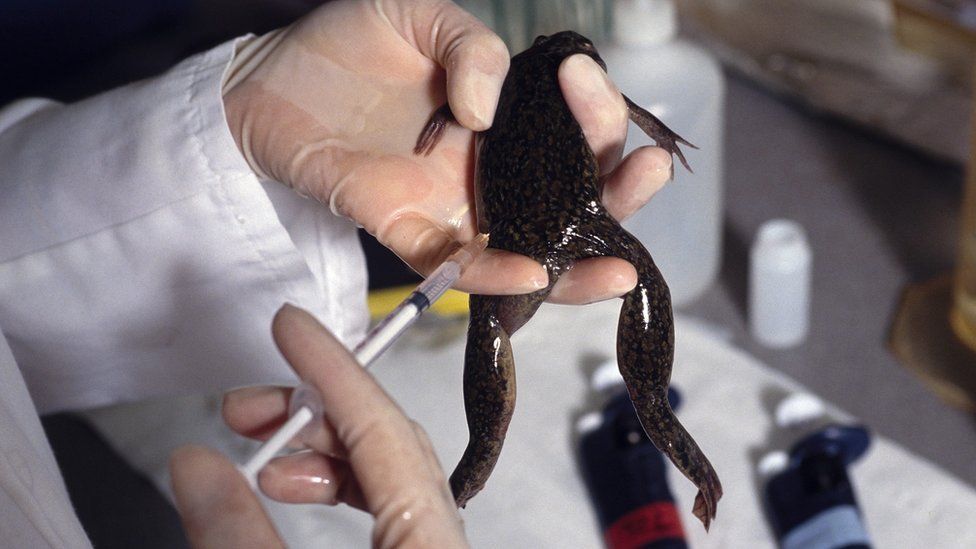Escapee pregnancy test frogs colonised Wales for 50 years
- Published

Prior to conventional pregnancy tests being widely available, would-be parents often relied on the help of the African clawed frog to confirm the good news.
In the first half of the 20th Century, doctors would inject a woman's urine under a female frog's skin and - if she was pregnant - it would cause the amphibian to produce eggs.
This test was uncovered by English biologist Lancelot Hogben during his studies in South Africa in the 1920s.
Following this discovery, the frogs were kept at four centres in the UK, but a number escaped their clinical confines and made a new home for themselves in a pocket of south Wales.
Researchers tracked them down to two areas, but kept their location secret - so what happened to the amphibian escape artists and where are they now?
Almost 60 years on from the arrival of Wales' unlikely new lodgers, it still isn't known precisely how - or when - the frogs made their way here.
The Welsh Government said it was "most likely that it took place in the early 1960s and was a result of being released or an escape".
Evidently, what is now Bridgend and Vale of Glamorgan offered everything to fit their needs, so Xenopus laevis - to use the creature's scientific name - settled in.
The first reported sighting was in Cwm Alun in 1966 and a breeding population was well-established by the 1970s.
In the 1980s, a colony was uncovered in a stream at Dunraven Castle in Southerndown, along the River Alun and ponds upstream to nearby Croescwtta.
David Slade, of the South East Wales Biodiversity Records Centre, said: "So effectively they were known from Glamorgan for a number of years, around the Alun Valley, and Bristol University conducted extensive long-term research projects on them whilst keeping the location secret."
Frog factfile
- Males weigh 2oz (60g) and are about 2.5in (6cm) long. Females weigh about 7oz (200g) and can reach 4.5in (12cm)
- Native to eastern and southern Africa, as well as South Africa, Namibia and Angola
- Prefer warm, stagnant pools and only leave the water when forced to move
- Feed on insect larvae, water insects, crustaceans, small fish, tadpoles, worms and freshwater snails
- Can live to be 16 in the wild or 20 in captivity
Scientists began a programme of capturing, marking and releasing the animals - finding about 2,000 individuals between 1981 and 2010.
This programme recorded two frogs living for at least 14 years - typical for the animal, despite the colder conditions it was in - and in one night in 2006, 345 were found living in one pond.
By 2008, the Welsh Government - fearing the possible transmission of the fatal chytrid fungus to native amphibians - decided upon an eradication programme.
The plan was to trap breeding adults in spring/summer 2010 and take them to a laboratory to give them a fatal dose of anaesthetic.
But nature beat them to it.
After laying an extensive number of traps, not a single African clawed frog was captured and researchers found this mass disappearance coincided with one in Lincolnshire - another place they colonised.
Scientists think severe winters in 2009 and 2010 - including the coldest December on record and the third driest December in 100 years - killed off the animals.
Ponds dried out, preventing tadpoles developing into adults, and cannibalism of tadpoles by adults was thought to be a factor brought on by frogs living in isolated ponds, restricting their ability to find food.
More than 1,200 trapping attempts in 2010 and 2011 yielded the capture of just one adult male on 19 May 2010 - the same frog that had been caught nine times in the previous five years.
And that was the last anyone saw of them - further traps were laid up until 2014 - but caught nothing.
Despite the frogs' extended stay in Wales, the National Center for Biotechnology Information said there was "no formal reaction to the presence of a breeding colony, and research published during 25 years did not attract conservation concerns".
The Welsh Government said a report concluded there was "a high level of confidence that no frogs remained in the main area where Xenopus had been found previously".
However, it did acknowledge there could be a small nucleus of surviving frogs elsewhere due to the animal's long lifespan and it was possible "isolated frogs could begin to breed some time after the eradication if they were to come into contact".
Mr Slade said the frogs "appear to have been eradicated".
Amphibian and Reptile Conservation, which carries out intermittent surveys, said there had not been any signs of the frogs' return, but they hadn't done a survey in recent years.
So, if you find yourself walking in this corner of Wales and think you've come across an African clawed frog, there's a sure-fire way to check.
You'll just need a very understanding pregnant friend.
Related Topics
- Published21 August 2018
- Published25 August 2018
- Published16 April 2017
- Published26 June 2014